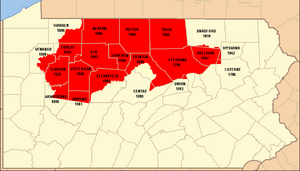List of municipalities in Lycoming County, Pennsylvania facts for kids
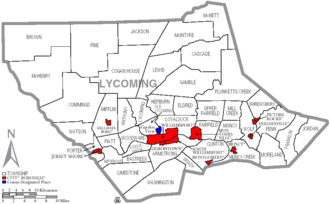
There are 52 municipalities in Lycoming County, Pennsylvania. Under Pennsylvania law, there are three types of incorporated municipalities in Lycoming County: cities, boroughs and townships. Any municipality in Pennsylvania with more than 10 persons can incorporate as a borough. Any township or borough with a population of at least 10,000 can ask the state legislature to become chartered as a city. There are no unincorporated areas in the county, since all territory in Pennsylvania is incorporated.
The 52 incorporated municipalities in Lycoming County are the subject of the first list, which gives their names and etymologies, dates settled and incorporated, what they were formed from, area, population, and location within the county. Two other lists dealing with former parts of Lycoming County are included. The second list is of former incorporated townships and gives the same information as above on their current status. The third list gives information on the eighteen other Pennsylvania counties which were formed from or contain land originally in the county.
In the 2000 census, the population of Lycoming County was 120,044, making it a "Fifth Class County" (defined by Pennsylvania law as "having a population of 95,000 and more, but less than 145,000 inhabitants"). It is included in the Williamsport, Pennsylvania metropolitan statistical area, whose county seat is Williamsport. Lycoming County is located in north central Pennsylvania, about 130 miles (209 km) northwest of Philadelphia and 165 miles (266 km) east-northeast of Pittsburgh, as the crow flies.
Municipalities
As of 2012, Lycoming County has 52 incorporated municipalities: one city, nine boroughs, and 42 townships. Lycoming County's townships include one census-designated place (CDP) and 50 villages. CDPs are geographical areas designated by the U.S. Census Bureau for the purposes of compiling demographic data. Villages are marked with signs by the Pennsylvania Department of Transportation. Neither CDPs nor villages are actual jurisdictions under Pennsylvania law and their territory is legally part of the township(s) where they are located. The first list also notes the CDP and villages within their respective townships.
At 1,244 square miles (3,220 km2) as of 2012, Lycoming County is the largest county by land area in Pennsylvania. While Erie County is larger, nearly half of its area is in Lake Erie. Lycoming County is also larger than Rhode Island, the smallest U.S. state, which has an area of 1,214 square miles (3,140 km2). Its incorporated municipalities range in size from 0.6 square miles (1.6 km2) (three of the boroughs) to 76.5 square miles (198 km2) (McHenry Township). The city of Williamsport has the highest population of any municipality (30,706 or 25.6% of the county total as of 2000), while Brown Township in the northwest corner of the county has the lowest population (111 or 0.092%). Most of the county's population is in the valley along the West Branch Susquehanna River.
-
Lycoming County Courthouse, Williamsport -
Rose Valley Lake, Gamble Township -
Little League World Series, South Williamsport -
White Deer Hole Creek in Washington Township
| Municipality (type) |
Remarks | Settled | Incorporated | Formed from | Area in square miles (km2) | Population as of 2000 |
Map |
|---|---|---|---|---|---|---|---|
| Williamsport (city) | Named for William Ross (son of founder Michael Ross); county seat; laid out 1796 | 1769 | 1806 (borough), 1866 (city) |
Loyalsock Township | 9.5 sq mi (24.7 km2) |
30,706 |  |
| Duboistown (borough) | Named for founders John and Mathias Dubois, laid out 1852 | 1773 | 1878 | Armstrong Township | 0.6 sq mi (1.7 km2) |
1,280 |  |
| Hughesville (borough) | Named for founder Jeptha Hughes; laid out 1816 | 1816 | 1852 | Muncy Township | 0.6 sq mi (1.7 km2) |
2,200 |  |
| Jersey Shore (borough) | Named the "Jersey Shore" as its founders were from New Jersey and it was on the shore of the West Branch Susquehanna River; laid out 1820 | 1785 | 1826 | Porter Township | 1.2 sq mi (3.2 km2) |
4,482 |  |
| Montgomery (borough) | Named for the "Montgomery Station" post office; known as "Black Hole" until circa 1836 (for Black Hole Creek) | 1783 | 1887 | Clinton Township | 0.6 sq mi (1.5 km2) |
1,695 |  |
| Montoursville (borough) | Named for Madame Montour and her son Andrew Montour; laid out 1820 | 1768 | 1850 | Fairfield Township | 4.2 sq mi (10.8 km2) |
4,777 |  |
| Muncy (borough) | Named for the Munsee phratry of the Lenape; laid out 1797 | 1797 | 1826 | Muncy Township | 0.8 sq mi (2.2 km2) |
2,663 |  |
| Picture Rocks (borough) | Named for Indian pictographs found on the cliffs above Muncy Creek | 1848 | 1875 | Wolf Township | 0.9 sq mi (2.4 km2) |
693 |  |
| Salladasburg (borough) | Named for founder Jacob P. Sallada; laid out 1837 | 1837 | 1884 | Mifflin Township | 0.8 sq mi (2.0 km2) |
260 |  |
| South Williamsport (borough) | Named for its geographic location, south of Williamsport; | 1790 | 1886 | Armstrong Township | 2.1 sq mi (5.5 km2) |
6,412 |  |
| Anthony Township | Named for Joseph B. Anthony, a county judge circa 1844 and later Pennsylvania Supreme Court justice | 1773 | 1844 | Lycoming Township | 15.9 sq mi (41.1 km2) |
904 |  |
| Armstrong Township | Named for James Armstrong, a local lawyer | 1795 | 1842 | Clinton Township | 25.6 sq mi (66.2 km2) |
717 |  |
| Bastress Township | Named for Solomon Bastress of Jersey Shore, former member of the state legislature and associate judge | 1837 | 1854 | Susquehanna Township | 8.6 sq mi (22.4 km2) |
574 |  |
| Brady Township | Named for the Brady family, some of the earliest settlers in the area | 1790 | 1855 | Washington Township | 8.6 sq mi (22.4 km2) |
494 |  |
| Brown Township | Named for Jacob Brown, a general from Pennsylvania in the War of 1812; includes the villages of Cedar Run and Slate Run | 1790 | 1815 | Mifflin and Pine Townships | 73.7 sq mi (190.8 km2) |
111 |  |
| Cascade Township | Named for its cascading mountain streams; includes the village of Kellyburg | 1843 | 1843 | Hepburn and Plunketts Creek Townships | 40.9 sq mi (105.9 km2) |
419 |  |
| Clinton Township | Named for DeWitt Clinton, governor of New York (1817–1822, 1824–1828) | 1825 | 1825 | Washington Township | 28.8 sq mi (74.5 km2) |
3,947 |  |
| Cogan House Township | Named for David Cogan, a pioneer who settled on Larrys Creek in 1825; includes the villages of Beech Grove, Brookside, Cogan House, and White Pine | 1825 | 1843 | Jackson and Mifflin Townships | 69.9 sq mi (181.1 km2) |
974 |  |
| Cummings Township | Named for John Cummings, an associate on the bench; includes the village of Waterville, as well as two state parks: Little Pine and Upper Pine Bottom | 1784 | 1832 | Mifflin and Brown Townships | 69.4 sq mi (179.7 km2) |
355 |  |
| Eldred Township | Named for C. D. Eldred, an associate on the bench; includes the village of Warrensville | 1802 | 1858 | Hepburn Township | 14.3 sq mi (37.1 km2) |
2,178 |  |
| Fairfield Township | Named for "beautiful rolling land of the fertile river bottom" | 1742 | 1825–1826 | Muncy Township | 11.7 sq mi (30.4 km2) |
2,659 |  |
| Franklin Township | Named for Benjamin Franklin; includes the village of Lairdsville | 1795 | 1822 | Moreland Township | 24.5 sq mi (63.4 km2) |
915 |  |
| Gamble Township | Named for James Gamble, the judge who authorized the election that led to its creation; includes the village of Calvert and Rose Valley Lake | 1784 | 1875 | Lewis and Cascade Townships | 46.2 sq mi (119.5 km2) |
854 |  |
| Hepburn Township | Named for William Hepburn, a founding father of Williamsport and Lycoming County; includes the villages of Cogan Station (also in Lycoming Township) and Hepburnville | 1784 | 1804 | Loyalsock Township | 16.6 sq mi (43.1 km2) |
2,836 |  |
| Jackson Township | Named for Andrew Jackson (prior to his presidency); includes the village of Buttonwood | 1811 | 1824 | Lycoming Township | 35.6 sq mi (92.2 km2) |
414 |  |
| Jordan Township | Named for Alexander Jordan, president judge of the district court when formed; includes the villages of Lungerville and Unityville | 1812 | 1854 | Franklin Township | 20.7 sq mi (53.6 km2) |
878 |  |
| Lewis Township | Named for Ellis Lewis, president judge of the district court when formed; includes the villages of Bodines, Field Station, and Trout Run | 1812 | 1835 | Hepburn Township | 37.8 sq mi (98.0 km2) |
1,139 |  |
| Limestone Township | Named for its abundant limestone, originally known as "Adams Township" for John Adams (name changed 1835); includes the villages of Collomsville, Oriole, and Oval | 1789 | 1824 | Nippenose and Wayne Townships | 34.2 sq mi (88.5 km2) |
2,136 |  |
| Loyalsock Township | Named for Loyalsock Creek; second most populous municipality in the county | 1768 | 1786 | Muncy Township | 21.2 sq mi (55.0 km2) |
10,876 |  |
| Lycoming Township | Named for Lycoming Creek; includes the villages of Cogan Station (also in Hepburn Township) and Quiggleville | 1773 | 1858 | Old Lycoming Township | 15.4 sq mi (39.8 km2) |
1,606 |  |
| McHenry Township | Named for Alexander H. McHenry, a Jersey Shore surveyor; includes the villages of Cammal, Haneyville, Jersey Mills, and Okome | 1785 | 1861 | Brown and Cummings Townships | 76.5 sq mi (198.1 km2) |
145 |  |
| McIntyre Township | Named for Archibald McIntyre, a founder of the Williamsport and Elmira Railroad; includes the villages of Marsh Hill and Ralston | 1794 | 1848 | Lewis Township | 47.2 sq mi (122.4 km2) |
539 |  |
| McNett Township | Named for H. I. McNett, who led the drive for its formation; includes the villages of Chemung, Ellenton, Leolyn, Penbryn, and Roaring Branch | 1805 | 1878 | McIntyre Township | 33.8 sq mi (87.5 km2) |
211 |  |
| Mifflin Township | Named for Thomas Mifflin, the first governor of Pennsylvania (1790–1799) | 1790 | 1803 | Old Lycoming Township | 27.9 sq mi (72.2 km2) |
1,145 |  |
| Mill Creek Township | Named for Mill Creek; includes part of the village of Huntersville (also in Wolf Township) | 1795 | 1879 | Muncy Township | 11.4 sq mi (29.5 km2) |
572 |  |
| Moreland Township | Named for a legend that the acres surveyed here were larger than a standard acre; includes the village of Opp | 1790 | 1813 | Muncy Creek Township | 23.9 sq mi (62.0 km2) |
1,036 |  |
| Muncy Township | Named for the Munsee phratry of the Lenape; as it is older than Lycoming County, it is often called the "Mother Township"; includes the village of Pennsdale | 1772 | 1772 | One of the seven original townships of Northumberland County | 15.8 sq mi (40.8 km2) |
1,059 |  |
| Muncy Creek Township | Named for Muncy Creek; includes the village of Clarkstown | 1773 | 1797 | Muncy Township | 20.7 sq mi (53.7 km2) |
3,487 |  |
| Nippenose Township | Named for the Indian phrase, "Nippeno-wi", meaning a warm and genial summer like place; includes the village of Antes Fort, which was named for Fort Antes (abandoned during the Big Runaway) | 1769 | 1786 | Bald Eagle Township | 11.2 sq mi (29.1 km2) |
729 |  |
| Old Lycoming Township | Named indirectly for Lycoming Creek, it was originally part of Lycoming Township, the name was changed in 1858 when the township was divided; includes the census-designated place of Garden View | 1773 | 1785 | Iroquois land purchased as part of Northumberland County, before this was run by the Fair Play Men | 9.5 sq mi (24.6 km2) |
5,508 |  |
| Penn Township | Named for Penn Township, Berks County; includes part of the village of Glen Mawr (also in Shrewsbury Township) | 1774 | 1828 | Muncy Township | 26.7 sq mi (69.2 km2) |
900 |  |
| Piatt Township | Named for William Piatt, an associate county judge when it was created; includes the village of Larryville | 1769 | 1858 | Mifflin Township | 10.1 sq mi (26.3 km2) |
1,259 |  |
| Pine Township | Named for its vast stands of pine trees; includes the villages of English Center and Oregon Hill | 1806 | 1856 | Brown, Cummings and Cogan House Townships | 75.8 sq mi (196.3 km2) |
329 |  |
| Plunketts Creek Township | Named for Plunketts Creek; includes the villages of Barbours and Proctor | 1776 | 1838 | Franklin Township and Davidson Township now part of Sullivan County | 55.2 sq mi (143.1 km2) |
771 |  |
| Porter Township | Named for David R. Porter, Pennsylvania governor (1839–1845) | 1772 | 1840 | Mifflin Township | 7.9 sq mi (20.6 km2) |
1,633 |  |
| Shrewsbury Township | Named for Shrewsbury Township, New Jersey; includes the villages of Glen Mawr (also in Penn Township) and Tivoli | 1794 | 1804 | Muncy Township | 17.5 sq mi (45.3 km2) |
433 |  |
| Susquehanna Township | Named for the West Branch Susquehanna River which forms the northern boundary; includes the village of Nisbet | 1801 | 1838 | Nippenose and Armstrong Townships | 7.8 sq mi (20.2 km2) |
993 |  |
| Upper Fairfield Township | Originally named "Pollock Township" for local judge, name changed to Fairfield Township in 1853; includes the villages of Farragut and Loyalsockville | 1796 | 1851 | Fairfield Township | 18.2 sq mi (47.2 km2) |
1,854 |  |
| Washington Township | Named for George Washington; includes the village of Elimsport | 1760 | 1785 | Bald Eagle Township | 48.5 sq mi (125.7 km2) |
1,613 |  |
| Watson Township | Named for Oliver Watson, president of a bank in Williamsport; includes the village of Tombs Run | 1784 | 1845 | Porter and Cummings Townships | 23.5 sq mi (61.0 km2) |
550 |  |
| Wolf Township | Named for George Wolf, governor of Pennsylvania (1829–1835); | 1777 | 1834 | Muncy Township | 19.6 sq mi (50.7 km2) |
2,707 |  |
| Woodward Township | Named for Apollos Woodward, an associate judge; includes the village of Linden | 1772 | 1855 | Anthony Township | 13.6 sq mi (35.3 km2) |
2,397 |  |
| Garden View, (census-designated place) | Not a municipality, just a part of Old Lycoming Township | 1.0 sq mi (2.7 km2) |
2,679 |  |
-
Dunkard Church, Hepburn Township -
Covered Bridge in Cogan House Township
Former townships
The territory which today makes up Lycoming County was purchased from the Iroquois in two treaties signed at Fort Stanwix in New York: the first treaty was in 1768, and the second treaty was in 1784. The county was formed on April 13, 1795 from part of Northumberland County. The county originally contained seven townships when formed: Lower Bald Eagle, Loyalsock, Lycoming, Muncy, Nippenose, Pine Creek, and Washington. Today Pine Creek is part of Clinton County and Lower Bald Eagle is part of both Centre and Clinton counties, but the rest are still in Lycoming County, although many other municipalities have been formed from these since.
When originally formed in 1795, Lycoming County was "roughly estimated at about 12,000 square miles" (31,000 km2). Its territory stretched north to the New York state line, west to the Allegheny River, south nearly to the source of the West Branch Susquehanna River, and east to include modern Sullivan County and a bit beyond. However, by 1800, just five years after its formation, the first territory was taken from it to form new counties, a process that continued until 1847.
Twenty other Pennsylvania counties today contain land that was once part of Lycoming County: five were formed completely from it (Jefferson, McKean, Potter, Tioga, and Sullivan), eight were formed from it and other counties (Armstrong, Bradford, Centre, Clearfield, Clinton, Indiana, Venango, and Warren), three were formed from counties that were themselves formed partly from it (Cameron, Clarion, and Elk), Forest was formed from a county that was formed completely from it, two (Luzerne and Wyoming) contain territory that was part of lycoming County in 1795, and finally Union received a township from it in 1861.
The second table lists each of the twenty two known former incorporated areas in the county, and information on the modern township successors of these today. Note that former townships are only known for nine of the twenty counties containing land from Lycoming.
| Municipality (type) |
Remarks | Settled | Incorporated | Area in square miles (km2) | Population as of 2000 |
Map |
|---|---|---|---|---|---|---|
| Allison Township | Now in Clinton County, incorporated as part of Lycoming County | ? | before 1839 | 2.0 mi2 (5.2 km2) |
198 |  |
| Brady Township (now Gregg Township) | Now in Union County, incorporated as part of Lycoming County | 1798 | 1798 | 15.1 mi2 (39.2 km2) |
4,687 | 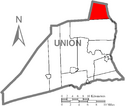 |
| Ceres Township | Now in McKean County, incorporated as part of Lycoming County | 1798 | 1798 | 40.7 mi2 (105.4 km2) |
1,003 |  |
| Chapman Township | Now in Clinton County, incorporated as part of Lycoming County | 1780 | before 1839 | 99.9 mi2 (258.7 km2) |
848 |  |
| Cherry Township | Now in Sullivan County, incorporated as part of Lycoming County | 1816 | 1824 | 57.8 mi2 (149.8 km2) |
1,718 |  |
| Colebrook Township | Now in Clinton County, incorporated as part of Lycoming County | 1777 | before 1839 | 18.7 mi2 (48.4 km2) |
179 |  |
| Davidson Township | Now in Sullivan County, incorporated as part of Lycoming County | 1806 | 1833 | 78.2 mi2 (202.3 km2) |
626 |  |
| Dunnstable Township | Now in Clinton County, incorporated as part of Lycoming County | 1785 | before 1810 | 9.6 mi2 (24.8 km2) |
993 |  |
| Elkland Township | Now in Sullivan County, incorporated as part of Lycoming County | 1798 | 1804 | 38.7 mi2 (100.2 km2) |
607 |  |
| Forks Township | Now in Sullivan County, incorporated as part of Lycoming County | 1794 | 1833 | 43.9 mi2 (113.7 km2) |
407 |  |
| Fox Township | Now in Sullivan County, incorporated as part of Lycoming County | 1800 | 1839 | 38.6 mi2 (100.0 km2) |
332 |  |
| Grove Township | Now in Cameron County, incorporated as part of Lycoming County, then one of twelve original townships in Clinton County (1839), then one of four original townships in Cameron (1860) | 1811 | before 1839 | 74.0 mi2 (191.6 km2) |
179 | 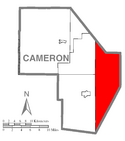 |
| Limestone Township (now Crawford Township) | Now in Clinton County, incorporated as part of Lycoming County, name changed 1841. | 1780 | 1824 | 22.1 mi2 (57.2 km2) |
848 |  |
| Lower Bald Eagle Township (now Bald Eagle Township) | Now in Clinton County, incorporated as part of Northumberland County, became part of Lycoming County in 1795 | 1772 | 1772 | 41.6 mi2 (107.7 km2) |
1,898 |  |
| Lumber Township | Now in Cameron County, incorporated as part of Lycoming County, then one of twelve original townships in Clinton County (1839), then one of four original townships in Cameron (1860) | 1810 | before 1839 | 51.5 mi2 (133.4 km2) |
241 |  |
| Pine Creek Township | Now in Clinton County, incorporated as part of Lycoming County | 1785 | 1772 | 14.9 mi2 (38.6 km2) |
3,184 |  |
| Pine Creek Township | Now in Jefferson County, incorporated as part of Lycoming County | 1785 | 1772 | 28.5 mi2 (73.9 km2) |
1,369 | 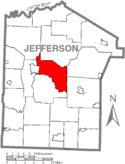 |
| Plunketts Creek Township (now Hillsgrove Township) | Now in Sullivan County, incorporated as part of Lycoming County, name changed in 1856. | 1786 | 1847 | 28.4 mi2 (73.6 km2) |
265 |  |
| Shrewsbury Township | Now in Sullivan County, incorporated as part of Lycoming County | 1799 | 1803 | 48.1 mi2 (124.5 km2) |
328 |  |
| Tioga Township | Now in Tioga County, incorporated as part of Lycoming County | 1792 | 1797 | 40.5 mi2 (104.8 km2) |
995 | 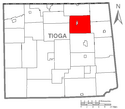 |
| Upper Bald Eagle Township (now Spring Township) | Now in Centre County, incorporated as part of Northumberland County, became part of Lycoming County in 1795; Name changed in 1801 to "Spring Township" | 1772 | 1772 | 25.9 mi2 (67.0 km2) |
6,117 |  |
| Wayne Township | Now in Clinton County, incorporated as part of Lycoming County; named for "Mad" Anthony Wayne | 1768 | 1798 | 22.8 mi2 (59.2 km2) |
1,363 |  |
-
Little Pine Creek Bridge in Cummings Township -
Eagle Grange No. 1, Clinton Township -
TWA Flight 800 Memorial in Montoursville
Clickable map
The map shown below is clickable; click on any municipality label to be redirected to the article for that city, borough or township.
Twp.
Twp.
Twp.
House
Twp.
Twp.
Twp.
Twp.
ming
Twp.
Twp.
Creek
Twp.
Twp.
Twp.
Creek Twp.
nose Twp.
Twp.
Creek
Twp.
Twp.
Twp.
Twp.
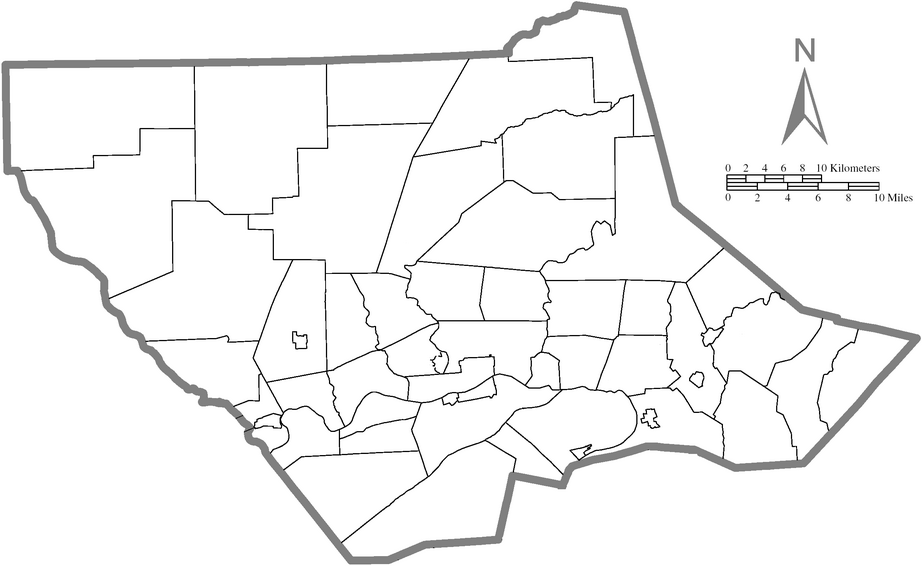
See also
- History of Lycoming County, Pennsylvania
- List of villages in Lycoming County, Pennsylvania











